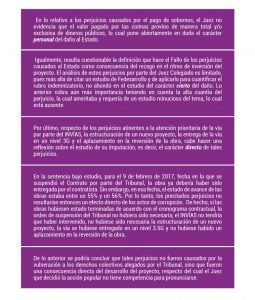December 6, 2018, the First Section of the Administrative Court of Cundinamarca issued a ruling whose analysis is mandatory in matters of contractual and extra-contractual liability. Said judgment took place on the occasion of the corruption scandal at the head of Odebrecht, which led to the awarding and execution of Concession Contract No. 001 of 2010 and Others 3 and 6, the purpose of which consisted of the construction of the works corresponding to the Ruta del Sol Sector II and the Ocaña-Gamarra corridor.
The aforementioned ruling permanently suspended the effects of the Concession Contract, together with its additions and modifications. In addition, it jointly condemned the Ruta del Sol Concessionaire Society, all its members (the construction companies of Odebrecht, EPISOL -a subsidiary of Corficolombiana- and CSS Constructores) and the natural persons Gabriel García, José Elías Melo, Otto Bula, Luiz Antonio Bueno , Luiz Antonio Mameri and Luiz Eduardo Da Rocha, as authors of the damages suffered by the State. The defendants were declared disqualified for 10 years from proposing and entering into contracts with Colombian public entities and holding public office, and they were jointly sentenced to answer for more than $ 800 billion pesos ($ 800,156’144,362.50). </ p>
In order to support the substantial conviction, the Court argued the violation by the convicted of collective rights, such as administrative morality, defense of public heritage, efficient and timely access to public services and free economic competition. This as a consequence of their acts of corruption.
In order to clarify the provenance of the large sentence imposed by the Collegiate Judge, a brief description of each of the damages defined by the Court:
I) Damages caused by the payment of bribes ($ 35,101’419,000):
The estimated figure for this damage corresponds to the value in Colombian pesos of the bribes paid to public officials in order to achieve the award and modification of the Concession Contract ( $ 11.1 million). To support the collection of this damage from the convicted persons, the Court stated that the value paid for the bribes came from public money, since fictitious contracts financed with the resources of the concession contract were signed in order to disguise the acts of corruption. < / span>
II. Damages caused as a result of the selection of the most expensive offer ($ 128,042’783,145.20):
This item refers to the damages caused to the State by virtue of the award of the project under study to the future Ruta del Sol Concessionaire Society, which, in due course, submitted the most expensive bid, as opposed to two other bidders. To estimate this damage, the Court determined the cost overrun taking into account the average of the sums of the two financial offers of the non-successful bidders.
III. Damages caused as a consequence of the lag in the project’s investment rate ($ 87,329’454,951.74):
To estimate this damage, the Court relied on a Fedesarrollo study to affirm that “for every peso… that is invested in large infrastructure works, 1, 13 pesos the production of the economy ”. According to the analysis carried out in the judgment, investments for the development of the project were stopped for more than 8 months. The quantification of this item was made taking into account the average monthly amount of investments multiplied by their detention time, whose result was multiplied by 1.13 (amount determined by Fedesarrollo regarding the negative effects on the economy caused by the lack of investment).
IV. Damages caused as a result of the priority attention of the road by INVÍAS ($ 90,000,000,000):
In the ruling, the steps taken by INVÍAS were accredited in order to achieve the passability and safety of the road. Such activities, corresponding to tasks directed to the operation and maintenance of the road, were carried out as a priority and required the appropriation by INVÍAS of $ 90,000,000,000.
V. Damages caused by the structuring of a new project($ 5,485’000,000):
This damage refers to the value of the contracts signed by the ANI in order to structure a new PPP for the continuation of the road project. This item included the values of the specialized Consulting Contract, whose purpose is aimed at the formulation of the APP, and the respective Audit Contract.
VI. Damages caused by the delay in the delivery of the road at Level 3G ($ 409,500’000,000):
In determining this damage, the Court took into account the time during which the road, although it may be used by users, will not have the 3G level initially agreed. The Collegiate Judge settled this item taking into account the monthly amount of tolls collected, multiplied by the number of months of the delay in the reception of 3G works. This result was reduced by 50%, taking into account the current benefit reported by users when using the road, even if it does not have a 3.5G level.
VII. Damages caused by the postponement in the reversion of the Work ($ 44,337’487,265.56):
According to the Court, these damages are derived from the 8-year delay that the reversion of the work will have in accordance with the difference between what was initially agreed with the Ruta Concessionaire del Sol and the reversal determined in the new APP.
In our opinion, several of the damages defined by the Court do not meet all the characteristics required by jurisprudence and doctrine on liability in order to qualify as compensable. Thus, some of the 7 damages are not personal, true and / or direct, as will be briefly explained.

By way of conclusion, we understand that, although the ruling under study sought to punish in an exemplary manner the acts of corruption of the accused, it is unfortunate that the Court has not adhered to Strictly to the parameters required by the doctrine and jurisprudence in matters of liability when determining compensable damages.
* Thanks to the lawyer Manuela Canal Silva for her participation in the preparation of the document.
